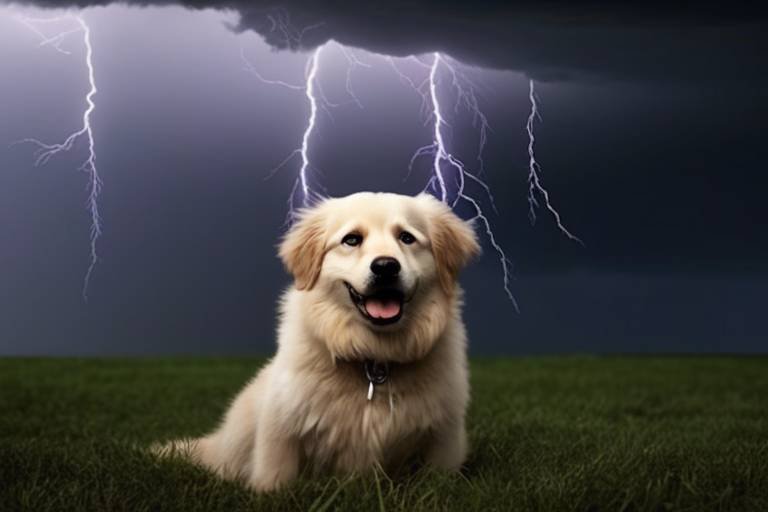Understanding Your Pet’s Dietary Restrictions
When it comes to our beloved furry friends, their health and happiness are paramount. Just like us, pets have unique dietary needs that can significantly affect their overall well-being. In this article, we will explore the intricacies of pet nutrition, particularly focusing on dietary restrictions that many pets face. These restrictions can stem from various factors including allergies, intolerances, or even specific medical conditions. Understanding these challenges is crucial for ensuring that our pets thrive and live their best lives.
Imagine trying to find the perfect meal for your pet, only to discover that they can't eat certain foods. This can be a frustrating experience, but with the right knowledge, you can navigate these dietary waters with ease. The first step is recognizing that not all pets can enjoy the same types of food. Just as some people are lactose intolerant or allergic to peanuts, pets can have their own set of dietary restrictions that must be respected.
To effectively cater to your pet’s dietary needs, it’s essential to be aware of the common dietary restrictions that can affect them. Some pets may have food allergies that lead to uncomfortable symptoms, while others might have intolerances that can cause gastrointestinal distress. By learning to identify these issues, you can make informed decisions about what to feed your furry companion.
In the following sections, we will delve deeper into identifying food allergies, choosing the right food, and consulting with veterinarians. Together, we can ensure that our pets receive a balanced diet that not only meets their nutritional requirements but also promotes their health and happiness.
Many pets experience dietary restrictions due to allergies, intolerances, or medical conditions. Understanding these common issues is crucial for providing the best care and nutrition tailored to their specific needs.
Recognizing food allergies in pets can be challenging. Symptoms may vary, and identifying triggers requires careful observation and sometimes elimination diets to ensure your pet's health and comfort.
Pets may exhibit various symptoms such as itching, gastrointestinal upset, or skin irritations due to food allergies. Understanding these signs can help in timely diagnosis and treatment.
Skin reactions, including rashes and excessive itching, are common indicators of food allergies. Monitoring your pet’s skin condition can provide valuable insights into potential dietary issues.
Gastrointestinal problems, such as vomiting or diarrhea, can signal food intolerances or allergies. Keeping a food diary can help pinpoint problematic ingredients for your pet.
Implementing an elimination diet is an effective method to diagnose food allergies. This process involves removing specific ingredients and gradually reintroducing them to monitor your pet's reaction.
Selecting the appropriate food for pets with dietary restrictions is essential. Understanding ingredients, reading labels, and consulting with veterinarians can help ensure a balanced diet that meets their needs.
Understanding how to read pet food labels is vital for identifying allergens and ensuring the diet is appropriate. Look for clear ingredient lists and avoid fillers that may cause issues.
Veterinarians can provide tailored advice on dietary choices for pets with restrictions. Regular consultations can help adapt the diet based on your pet's health and nutritional needs.
- What are the most common food allergies in pets? Common allergens include beef, chicken, dairy, wheat, and soy.
- How can I tell if my pet has a food allergy? Look for symptoms like itching, digestive upset, or skin irritations.
- What is an elimination diet? An elimination diet involves removing certain foods from your pet's diet to identify allergens.
- Should I consult a veterinarian about my pet's diet? Yes, a veterinarian can provide personalized dietary advice based on your pet's health.

Common Dietary Restrictions in Pets
This article explores the dietary needs of pets, highlighting common restrictions, nutritional guidelines, and how to ensure a balanced diet that promotes health and well-being for your furry companions.
Many pets experience dietary restrictions due to allergies, intolerances, or medical conditions. Understanding these common issues is crucial for providing the best care and nutrition tailored to their specific needs. Just like humans, pets can have unique dietary requirements that, if ignored, can lead to serious health problems. Imagine feeding your pet something that makes them feel unwell—it's not just unfortunate; it's preventable!
Common dietary restrictions in pets often stem from ingredients that can cause adverse reactions. Some pets may be allergic to certain proteins, like chicken or beef, while others might struggle with grains, dairy, or specific additives. These restrictions can manifest in various ways, and recognizing them early can save your pet from discomfort. Here are a few common dietary restrictions you might encounter:
- Food Allergies: These can cause symptoms ranging from skin irritations to gastrointestinal distress.
- Food Intolerances: Unlike allergies, intolerances do not involve the immune system but can still lead to discomfort, such as bloating or diarrhea.
- Medical Conditions: Conditions like diabetes or kidney disease often require special diets to manage health effectively.
Understanding these dietary restrictions is not just about avoiding certain foods; it’s about ensuring your pet receives a balanced diet that supports their overall health. For instance, a pet with a grain intolerance may thrive on a grain-free diet rich in proteins and healthy fats. On the other hand, a pet with a specific allergy might need a limited ingredient diet to avoid triggers. This is where the journey of finding the right food can get tricky, but it’s essential for your pet's happiness.
To help you navigate this, remember to keep an eye on your pet’s behavior and health. If you notice any unusual symptoms—like excessive scratching, vomiting, or changes in appetite—these could be signs of an underlying dietary issue. Keeping a close watch on your pet can help you catch these problems early, ensuring they receive the care they need.
In summary, understanding common dietary restrictions in pets is the first step toward providing them with the best nutrition possible. By learning to identify potential issues and adapting their diet accordingly, you can help your furry friends lead healthier, happier lives.
Recognizing food allergies in pets can be challenging. Symptoms may vary, and identifying triggers requires careful observation and sometimes elimination diets to ensure your pet's health and comfort.
Pets may exhibit various symptoms such as itching, gastrointestinal upset, or skin irritations due to food allergies. Understanding these signs can help in timely diagnosis and treatment.
Skin reactions, including rashes and excessive itching, are common indicators of food allergies. Monitoring your pet’s skin condition can provide valuable insights into potential dietary issues.
Gastrointestinal problems, such as vomiting or diarrhea, can signal food intolerances or allergies. Keeping a food diary can help pinpoint problematic ingredients for your pet.
Implementing an elimination diet is an effective method to diagnose food allergies. This process involves removing specific ingredients and gradually reintroducing them to monitor your pet's reaction.
Selecting the appropriate food for pets with dietary restrictions is essential. Understanding ingredients, reading labels, and consulting with veterinarians can help ensure a balanced diet that meets their needs.
Understanding how to read pet food labels is vital for identifying allergens and ensuring the diet is appropriate. Look for clear ingredient lists and avoid fillers that may cause issues.
Veterinarians can provide tailored advice on dietary choices for pets with restrictions. Regular consultations can help adapt the diet based on your pet's health and nutritional needs.
Q: How can I tell if my pet has a food allergy?
A: Look for symptoms like itching, gastrointestinal upset, or skin irritations. Keeping a food diary can help track any reactions.
Q: What should I do if I suspect my pet has food allergies?
A: Consult your veterinarian for guidance on implementing an elimination diet and finding the right food for your pet.
Q: Are there special diets for pets with medical conditions?
A: Yes, pets with conditions like diabetes or kidney disease often require specialized diets to manage their health effectively.

Identifying Food Allergies
Recognizing food allergies in pets can feel like searching for a needle in a haystack. The symptoms can be subtle and vary greatly from one furry friend to another. While some pets may show immediate reactions, others might take weeks to display any signs at all. It’s essential to be vigilant and observant, as understanding these common issues can significantly improve your pet's quality of life. So, how do you identify food allergies in your beloved companion?
First, it’s important to note that food allergies often manifest in two primary ways: through skin reactions and gastrointestinal issues. If your pet is scratching incessantly or developing rashes, it may be time to consider the possibility of a food allergy. On the other hand, if your pet is experiencing vomiting, diarrhea, or other digestive disturbances, these could also be red flags. Keeping a close eye on your pet’s behavior and physical condition can provide valuable clues.
So, what are the typical symptoms you should look out for? Pets may exhibit a range of reactions, including:
- Itching and Scratching: Excessive scratching or licking can indicate skin irritations caused by allergens.
- Gastrointestinal Upset: Vomiting or diarrhea can signal food intolerances or allergies.
- Skin Irritations: Rashes, redness, or hot spots are common signs that something is off in your pet's diet.
Understanding these signs is crucial for timely diagnosis and treatment. If your pet is showing any of these symptoms, it’s wise to consult your veterinarian for further evaluation.
Skin reactions are often the most noticeable indicators of food allergies. You might find your pet scratching at their ears or belly, or maybe they have developed bald patches from excessive grooming. Monitoring your pet’s skin condition can provide valuable insights into potential dietary issues. For instance, if your pet has suddenly developed a rash after switching to a new food, it could be time to investigate the ingredients more closely.
Gastrointestinal problems can be particularly distressing for both pets and their owners. Symptoms like vomiting or diarrhea can disrupt your pet’s daily routine and lead to discomfort. Keeping a food diary can be an effective strategy to help pinpoint problematic ingredients. By noting what your pet eats and any subsequent reactions, you can better identify trends and potential triggers in their diet.
Implementing an elimination diet is one of the most effective methods to diagnose food allergies. This process involves removing specific ingredients from your pet's diet and gradually reintroducing them to monitor their reactions. Think of it as a detective game—by isolating certain foods, you can uncover the culprit causing your pet's discomfort. It's crucial to work closely with your veterinarian during this process to ensure that your pet continues to receive balanced nutrition while you investigate their dietary needs.
Q: How long does it take to identify food allergies in pets?
A: Identifying food allergies can take several weeks, especially if you're implementing an elimination diet. It's essential to be patient and observant during this time.
Q: Can pets outgrow food allergies?
A: Some pets may outgrow certain food allergies, while others may have lifelong sensitivities. Regular consultations with your veterinarian can help you manage your pet's dietary needs effectively.
Q: What should I do if I suspect my pet has a food allergy?
A: If you suspect your pet has a food allergy, the first step is to consult your veterinarian. They can help you identify potential allergens and recommend appropriate dietary changes.
Symptoms of Food Allergies
Recognizing the symptoms of food allergies in your beloved pet is an essential step toward ensuring their health and happiness. Just like humans, pets can experience various reactions when they consume something their bodies can't tolerate. These reactions can manifest in different ways, making it crucial for pet owners to be vigilant and observant.
One of the most common signs of food allergies in pets is itching. If you notice your furry friend scratching more than usual or biting at their skin, it could be a red flag. This excessive scratching can lead to skin irritations or even infections, which can complicate the situation further. In addition to itching, you might see rashes or red patches on their skin. It's as if their skin is sending a distress signal, urging you to take action.
Another significant indicator of food allergies is gastrointestinal upset. This can include symptoms such as vomiting, diarrhea, or even bloating. If your pet has an upset stomach after trying a new food, it’s time to take a closer look at the ingredients. Keeping a food diary can be a game changer. By tracking what your pet eats and any subsequent reactions, you can identify potential allergens more easily.
In some cases, food allergies can also lead to more severe symptoms such as swelling around the face, particularly the eyes and muzzle. This can be alarming and may require immediate veterinary attention. It's vital to remember that just because a food has been well-tolerated in the past doesn’t mean it will always be safe. Allergies can develop over time, making it essential to stay alert.
To summarize, here are some key symptoms to watch for:
- Itching or scratching
- Skin rashes or irritations
- Vomiting or diarrhea
- Swelling of the face
Being proactive in observing these symptoms can lead to timely diagnosis and treatment, ensuring your pet remains healthy and comfortable. If you suspect your pet may have food allergies, consulting with a veterinarian is always a wise choice. They can help guide you through the process of identifying the triggers and finding the right dietary solutions.
Q: What should I do if I suspect my pet has a food allergy?
A: If you suspect your pet has a food allergy, it’s best to consult with your veterinarian. They can recommend an elimination diet or other tests to identify the allergen.
Q: Can food allergies develop suddenly in pets?
A: Yes, food allergies can develop at any age, even if your pet has been eating the same food for years.
Q: Are certain breeds more prone to food allergies?
A: Some breeds are more predisposed to allergies, but any pet can develop food sensitivities or allergies.
Q: How can I ensure my pet's diet is balanced?
A: Consult with your veterinarian to create a tailored diet plan based on your pet’s specific needs and restrictions.
Skin Reactions
When it comes to our furry friends, can be one of the most apparent signs of food allergies. Imagine your pet scratching incessantly, leaving you wondering if they’ve come into contact with something harmful or if it’s a dietary issue. Skin reactions often manifest as rashes, redness, and excessive itching, making it crucial to observe these symptoms closely. If your pet is constantly licking or biting at their paws, it could very well be a signal that their diet is not sitting well with them.
Many pet owners might not realize that the food they’re providing could be the culprit behind these uncomfortable reactions. The skin acts as a barrier, and when it’s compromised, it can lead to a host of problems such as infections or further irritation. It’s essential to monitor your pet's skin condition regularly. Here are some common types of skin reactions you might notice:
- Red or inflamed skin: This can indicate an allergic response, often accompanied by swelling.
- Rashes or hives: These can appear suddenly and may require immediate attention.
- Hair loss: Excessive scratching can lead to bald patches, which can be distressing for both you and your pet.
But what should you do if you notice these signs? First and foremost, it’s important to consult with your veterinarian. They can help determine if the skin reactions are indeed related to food allergies or if there are other underlying issues. In some cases, a simple change in diet can make a world of difference. Your vet might recommend trying a hypoallergenic diet or specific food trials to identify the offending ingredient.
Additionally, keeping a close eye on your pet’s environment can also help in managing skin reactions. Sometimes, it’s not just about what they eat; it can also be about what they come into contact with. Regular grooming and bathing with appropriate shampoos can soothe irritated skin and help remove allergens. Remember, your pet's comfort and happiness are paramount, and addressing skin reactions promptly can lead to a healthier, happier life for your beloved companion.
Q1: How can I tell if my pet has a food allergy?
A1: Common signs include itching, rashes, and gastrointestinal upset. If you notice these symptoms, consult your veterinarian for proper diagnosis.
Q2: What should I do if my pet has a skin reaction?
A2: First, consult your veterinarian. They can help identify the cause and recommend appropriate treatments or dietary changes.
Q3: Can I treat my pet's skin reactions at home?
A3: While some mild reactions can be managed at home, it's best to seek professional advice to ensure your pet receives the right care.
Q4: Are all skin reactions due to food allergies?
A4: Not necessarily. Skin reactions can also result from environmental allergies, parasites, or infections. A vet can help differentiate the causes.
Gastrointestinal Issues
Gastrointestinal problems in pets can be a real headache for both you and your furry friend. Imagine your pet, usually full of life and energy, suddenly feeling sluggish and uncomfortable. It's heartbreaking, right? Symptoms such as vomiting, diarrhea, or even a sudden change in appetite can indicate that something is off in their diet. Just like us, pets can have food intolerances or allergies that lead to these distressing symptoms. One moment they're happily munching on their favorite kibble, and the next, they’re running to the door, desperately needing to go outside. It’s essential to keep a close eye on their eating habits and any changes in their behavior.
To get to the root of the problem, you might consider keeping a food diary. This simple yet effective tool can help you track what your pet eats and when symptoms occur. By noting down the specific ingredients in their food, you can begin to identify patterns and pinpoint problematic foods. For instance, if your dog experiences diarrhea after eating chicken-based food, it might be a sign of an intolerance. In such cases, it’s crucial to eliminate that ingredient and observe your pet's reaction over time.
In addition to monitoring food intake, understanding the common gastrointestinal issues can empower you to take action quickly. Here are some common signs to watch for:
- Vomiting: This can range from occasional to frequent and may indicate various underlying issues.
- Diarrhea: Loose stools can lead to dehydration, so it's important to address this promptly.
- Loss of Appetite: If your pet suddenly refuses to eat, it could signal discomfort or illness.
Don’t forget that some gastrointestinal issues can be temporary, resulting from dietary changes or stress. However, if symptoms persist for more than a day or two, it’s time to consult your veterinarian. They can help determine whether an allergy or intolerance is at play and recommend the best course of action. Remember, a healthy diet is crucial for your pet's overall well-being, and addressing gastrointestinal issues promptly can make a significant difference in their quality of life.
Q: What should I do if my pet has diarrhea?
A: If your pet has diarrhea, monitor their condition closely. Ensure they stay hydrated and consider withholding food for 12-24 hours. If diarrhea persists, consult your veterinarian.
Q: How can I tell if my pet has a food allergy?
A: Look for symptoms such as itching, gastrointestinal upset, or skin irritations. Keeping a food diary can help you identify potential allergens.
Q: Are there specific diets for pets with gastrointestinal issues?
A: Yes, many brands offer specialized diets formulated for pets with food sensitivities. Consult your veterinarian for recommendations tailored to your pet’s needs.
Elimination Diets
This article explores the dietary needs of pets, highlighting common restrictions, nutritional guidelines, and how to ensure a balanced diet that promotes health and well-being for your furry companions.
Many pets experience dietary restrictions due to allergies, intolerances, or medical conditions. Understanding these common issues is crucial for providing the best care and nutrition tailored to their specific needs.
Recognizing food allergies in pets can be challenging. Symptoms may vary, and identifying triggers requires careful observation and sometimes elimination diets to ensure your pet's health and comfort.
Pets may exhibit various symptoms such as itching, gastrointestinal upset, or skin irritations due to food allergies. Understanding these signs can help in timely diagnosis and treatment.
Skin reactions, including rashes and excessive itching, are common indicators of food allergies. Monitoring your pet’s skin condition can provide valuable insights into potential dietary issues.
Gastrointestinal problems, such as vomiting or diarrhea, can signal food intolerances or allergies. Keeping a food diary can help pinpoint problematic ingredients for your pet.
Implementing an elimination diet is an effective method to diagnose food allergies. This process involves removing specific ingredients from your pet's diet and then gradually reintroducing them to monitor their reactions. It’s akin to detective work; you’re trying to uncover which food is the culprit behind your pet's discomfort. The elimination diet typically lasts for about 8 to 12 weeks, during which you will feed your pet a limited ingredient diet that contains only novel proteins and carbohydrates that they have never consumed before.
During this time, it's crucial to avoid any treats, table scraps, or flavored medications that might contain allergens. You might feel like you’re living in a food fortress, but it’s all worth it for your furry friend. After the elimination period, you’ll gradually reintroduce one ingredient at a time, waiting a few days between each addition to observe any potential reactions. This method helps pinpoint the exact cause of your pet's allergies.
Here's a simple table to illustrate the elimination diet process:
| Phase | Description |
|---|---|
| Elimination Phase | Feed a limited ingredient diet with novel proteins and carbohydrates for 8-12 weeks. |
| Reintroduction Phase | Gradually add one ingredient at a time, monitoring for any allergic reactions. |
| Observation Phase | Document any reactions to identify specific food allergies or intolerances. |
Keep in mind that patience is vital during this process. Some pets may take longer to show a reaction, while others may react quickly. Always consult with your veterinarian before starting an elimination diet to ensure it’s done safely and effectively. They can guide you on the best practices and help you select appropriate food options that cater to your pet's health needs.
Selecting the appropriate food for pets with dietary restrictions is essential. Understanding ingredients, reading labels, and consulting with veterinarians can help ensure a balanced diet that meets their needs.
Understanding how to read pet food labels is vital for identifying allergens and ensuring the diet is appropriate. Look for clear ingredient lists and avoid fillers that may cause issues.
Veterinarians can provide tailored advice on dietary choices for pets with restrictions. Regular consultations can help adapt the diet based on your pet's health and nutritional needs.
- What are the signs my pet may have a food allergy? Common signs include itching, skin irritations, vomiting, and diarrhea.
- How long does an elimination diet take? Typically, an elimination diet lasts between 8 to 12 weeks.
- Can I use homemade food for an elimination diet? Yes, but consult your vet to ensure it meets all nutritional requirements.
- What should I do if my pet reacts to a food? Stop feeding that food immediately and consult your veterinarian for further guidance.

Choosing the Right Food
When it comes to selecting the right food for your beloved pet, the choices can feel overwhelming. With so many brands, flavors, and types of pet food available, how do you ensure you're making the best choice for your furry friend? It's essential to focus on quality and nutritional value while also considering any dietary restrictions your pet may have. Just like humans, pets require a balanced diet to thrive, and understanding their specific needs is the first step in this journey.
First and foremost, understanding ingredients is crucial. Always look for high-quality protein sources, such as chicken, beef, or fish, listed as the first ingredient. Avoid foods that list vague terms like "meat by-products" or "animal meal," as these can contain low-quality ingredients. Remember, the best food for your pet should be made with real, recognizable ingredients. You wouldn't want to feed your pet something you can't pronounce, right?
Another important aspect is to read the labels carefully. Pet food labels can be tricky, often filled with marketing jargon that can mislead pet owners. Here’s a quick breakdown of what to look for:
| Label Component | What to Look For |
|---|---|
| Guaranteed Analysis | Check for protein, fat, fiber, and moisture content. |
| Ingredient List | High-quality ingredients should be listed first; avoid fillers. |
| Feeding Guidelines | Ensure the feeding amounts are appropriate for your pet's size and activity level. |
| Life Stage | Choose food appropriate for your pet's age (puppy, adult, senior). |
Moreover, it's beneficial to consult with your veterinarian. They can provide tailored advice based on your pet's health history and dietary restrictions. This is especially important if your pet has specific conditions such as allergies, diabetes, or obesity. Regular consultations can help you adapt your pet's diet over time, ensuring they receive the nutrients they need as they age.
In addition to consulting professionals, observe how your pet responds to different foods. Every pet is unique, and what works for one may not work for another. Keep an eye on their energy levels, coat condition, and overall well-being. If you notice any adverse reactions, such as vomiting or lethargy, it may be time to reassess their diet.
Lastly, don’t forget about the importance of variety. Just like us, pets can get bored with their food. Consider rotating different protein sources and flavors to keep mealtime exciting. However, introduce new foods gradually to avoid upsetting their stomachs. A little change can go a long way in keeping your pet happy and healthy!
- What should I do if my pet has a food allergy? Consult with your veterinarian to determine the best course of action, which may include an elimination diet.
- How can I tell if my pet's food is of good quality? Look for high-quality ingredients, read labels carefully, and choose brands with a good reputation.
- Is it okay to switch my pet's food frequently? It's best to introduce new foods gradually to avoid gastrointestinal upset.
- Can I feed my pet human food? Some human foods are safe for pets, but always check with your veterinarian first to avoid harmful ingredients.
Reading Food Labels
This article explores the dietary needs of pets, highlighting common restrictions, nutritional guidelines, and how to ensure a balanced diet that promotes health and well-being for your furry companions.
Many pets experience dietary restrictions due to allergies, intolerances, or medical conditions. Understanding these common issues is crucial for providing the best care and nutrition tailored to their specific needs.
Recognizing food allergies in pets can be challenging. Symptoms may vary, and identifying triggers requires careful observation and sometimes elimination diets to ensure your pet's health and comfort.
Pets may exhibit various symptoms such as itching, gastrointestinal upset, or skin irritations due to food allergies. Understanding these signs can help in timely diagnosis and treatment.
Skin reactions, including rashes and excessive itching, are common indicators of food allergies. Monitoring your pet’s skin condition can provide valuable insights into potential dietary issues.
Gastrointestinal problems, such as vomiting or diarrhea, can signal food intolerances or allergies. Keeping a food diary can help pinpoint problematic ingredients for your pet.
Implementing an elimination diet is an effective method to diagnose food allergies. This process involves removing specific ingredients and gradually reintroducing them to monitor your pet's reaction.
Selecting the appropriate food for pets with dietary restrictions is essential. Understanding ingredients, reading labels, and consulting with veterinarians can help ensure a balanced diet that meets their needs.
When it comes to ensuring your pet's dietary needs are met, is an essential skill that every pet owner should master. The pet food industry can be quite overwhelming with its myriad of options and marketing jargon, but understanding what goes into your pet’s food is crucial for their health. First and foremost, you should look for the ingredient list, which is usually displayed in descending order by weight. This means that the first few ingredients are the most significant components of the food. If you see a specific protein source, like chicken or beef, listed first, it’s a good sign that your pet is getting a quality source of protein.
In addition to the primary ingredients, you should also be wary of fillers and by-products. Fillers are often low-quality ingredients that serve no nutritional purpose and can trigger allergies or intolerances. Common fillers include corn, wheat, and soy. By-products, on the other hand, can be less desirable as they may include parts of the animal that are not typically consumed by humans. Understanding these terms can help you avoid potential allergens.
Moreover, it’s essential to look for any allergen warnings. Many pet food labels will indicate if the product contains common allergens such as dairy, eggs, or certain grains. If your pet has known allergies, this information is vital. Additionally, some brands may also include nutritional adequacy statements, which indicate whether the food meets the standards set by the Association of American Feed Control Officials (AAFCO). This is a good sign that the food is formulated to provide complete nutrition.
Lastly, don’t hesitate to consult with your veterinarian about the food you’re considering. They can provide invaluable insights tailored to your pet’s specific needs, especially if they have dietary restrictions. Remember, navigating pet food labels may seem daunting, but with a little knowledge and attention, you can make informed choices that keep your furry friend happy and healthy.
Common signs of food allergies include itching, gastrointestinal upset, and skin irritations. If you notice any unusual symptoms, consult your veterinarian.
Focus on the ingredient list, avoid fillers and by-products, check for allergen warnings, and look for nutritional adequacy statements from AAFCO.
It's best to transition your pet to a new diet gradually over several days to avoid gastrointestinal upset.
Absolutely! Your veterinarian can provide personalized recommendations based on your pet's health and dietary restrictions.
Consulting with Veterinarians
When it comes to ensuring your pet’s health, is one of the most critical steps you can take. These professionals are not just animal doctors; they are your partners in navigating the complex world of pet nutrition and dietary restrictions. Just like a compass guides a sailor through uncharted waters, a veterinarian can help steer you toward the right dietary choices for your furry friend.
Veterinarians can provide invaluable insights into your pet's specific dietary needs based on their health history, age, breed, and any existing medical conditions. For instance, some pets may require special diets due to chronic issues like diabetes or kidney disease, while others might just need a little tweak in their daily meals to avoid allergies. This is where the expertise of a veterinarian truly shines.
Moreover, during your consultations, it’s essential to be open and honest about your pet’s eating habits, any symptoms you’ve observed, and even their preferences. This information can significantly aid your veterinarian in making tailored recommendations. They might suggest a prescription diet or recommend switching to a different brand that uses higher quality ingredients. Remember, not all pet foods are created equal, and what works for one pet may not be suitable for another.
Another important aspect of consulting with veterinarians is the opportunity to discuss food labels and ingredient lists. They can help you decode the often-confusing terminology found on pet food packaging, ensuring you understand what your pet is consuming. This is crucial for avoiding allergens and ensuring your pet receives a balanced diet that promotes optimal health.
In some cases, your veterinarian might recommend regular follow-up appointments to monitor your pet’s progress, especially if you’ve implemented a new diet. These check-ins are vital as they allow for adjustments based on how your pet is responding to the changes. It’s akin to tuning a musical instrument; sometimes, a little fine-tuning is all it takes to achieve perfect harmony.
In summary, don’t underestimate the power of a good veterinary consultation. They are equipped with the knowledge and resources to help you make informed decisions about your pet’s diet. After all, a happy pet is a healthy pet, and with the right guidance, you can ensure your furry companion thrives.
- How often should I consult my veterinarian about my pet's diet? It's recommended to have regular check-ups, especially if your pet has dietary restrictions or health issues.
- Can I switch my pet's food suddenly? It's best to transition gradually to avoid gastrointestinal upset; consult your vet for a tailored plan.
- What if my pet refuses to eat the recommended diet? Talk to your veterinarian about alternative options or ways to make the food more appealing.
- Are homemade diets safe for pets? They can be, but it’s crucial to consult your vet to ensure they meet all nutritional needs.
Frequently Asked Questions
- What are common dietary restrictions for pets?
Many pets face dietary restrictions due to allergies, intolerances, or specific medical conditions. Common issues include sensitivities to certain proteins, grains, or additives in their food. Understanding these restrictions is key to providing a tailored diet that promotes your pet's overall health and happiness.
- How can I identify if my pet has a food allergy?
Identifying food allergies can be tricky. Look for symptoms like excessive itching, gastrointestinal upset, or skin irritations. Keeping a close eye on your pet's behavior and health can help you spot these signs early. If you notice any unusual symptoms, it might be time to consult with your vet.
- What are the symptoms of food allergies in pets?
Symptoms can vary widely, but common signs include skin reactions like rashes or hot spots, gastrointestinal issues such as vomiting or diarrhea, and behavioral changes. If your pet is scratching more than usual or has upset stomachs frequently, it could be related to their diet.
- What is an elimination diet, and how does it work?
An elimination diet involves removing specific ingredients from your pet's diet and then gradually reintroducing them one at a time. This process helps identify which foods may be causing allergic reactions. It's a careful approach that requires patience and observation, but it can be very effective.
- How should I choose the right food for my pet with dietary restrictions?
Choosing the right food starts with understanding the ingredients. Always read labels carefully to identify potential allergens and avoid fillers. Consulting with your veterinarian can also provide personalized guidance and help you select a diet that meets your pet's unique nutritional needs.
- Why is it important to consult with a veterinarian about my pet's diet?
Veterinarians are equipped with the knowledge to help you navigate dietary restrictions effectively. They can recommend specific foods, suggest dietary changes based on your pet's health, and monitor any ongoing issues. Regular check-ins can ensure your pet receives the best possible nutrition.



















